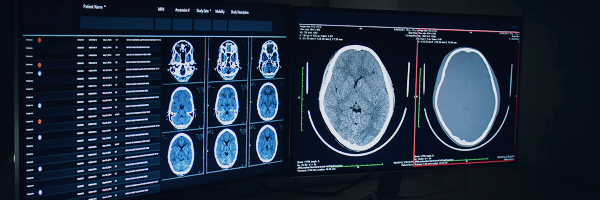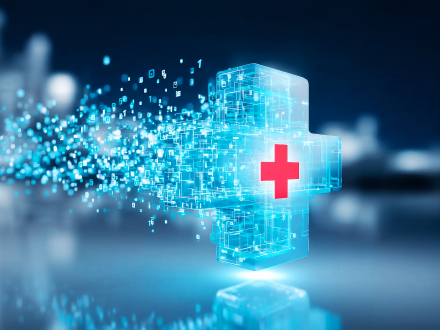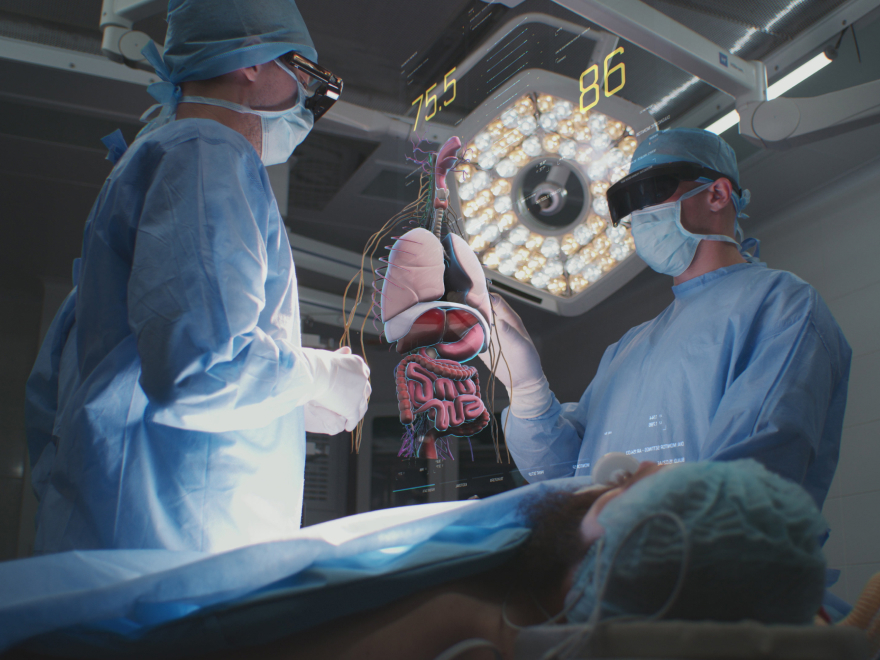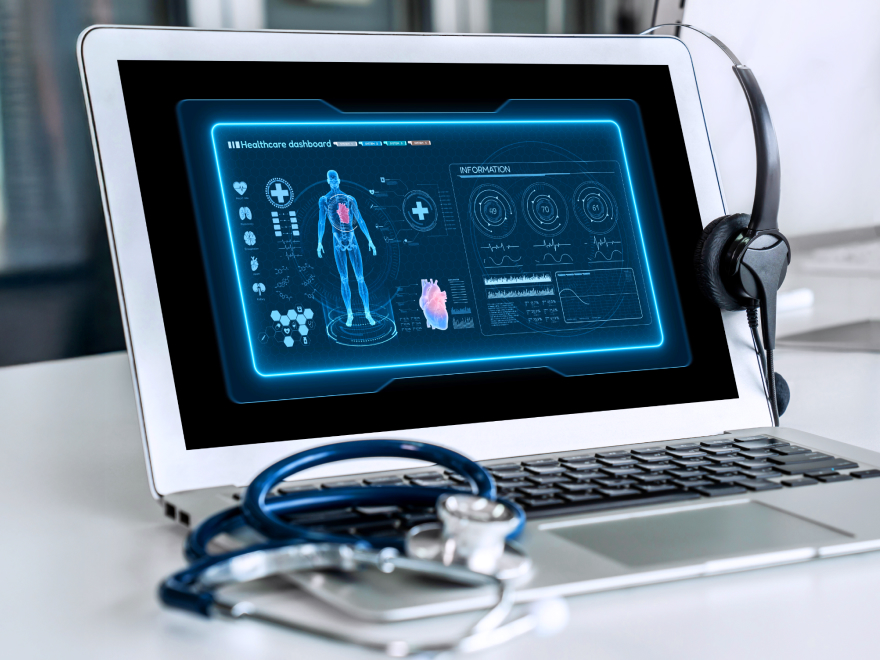Your message has been sent.
We’ll process your request and contact you back as soon as possible.
The form has been successfully submitted.
Please find further information in your mailbox.
AI has evolved by leaps and bounds, penetrating industries at a fierce pace, and is now overhauling the healthcare industry — from how diagnoses are made to how treatments are administered.
Progress is to be expected, but it begs the question; how is AI helping in the healthcare industry? In this article, we will explore AI technology in healthcare, how it will evolve, and how your healthcare or life sciences organization can capitalize on its potential right now.
By 2035, the healthcare AI market is expected to soar to $77.46B rising by 18.2% a year. The market expansion shows the growing importance of AI in healthcare, as populations are aging and chronic diseases dominate medical charts. The FDA also recognizes the potential of AI in the healthcare industry. By 2025, the agency has authorized more than 1,000 AI-enabled SaMD (software as a medical device), with the most popular categories being radiology, cardiology, and neurology.
It’s not just IT experts like me who welcome AI in healthcare. The American Medical Association found that 65% of physicians see advantages of AI, with 72% thinking it may help with diagnostics and 69% with workflow optimization. These positive sentiments, together with real-life results proving the role of AI in healthcare, push healthcare businesses towards AI development.

The use of artificial intelligence in healthcare virtually has no limits, making the industry better for patients and doctors alike. This versatility is probably why 93% of healthcare and life sciences companies plan to increase their AI spending in 2025. Here, we listed some applications of AI in the healthcare sector that you may consider a worthy investment.
AI algorithms in healthcare solutions analyze patient symptoms and medical histories to assist in triage and diagnostics. For example, before an appointment, AI chatbots ask patients about their symptoms, compile a record, and route them to the right medical professional. Also, AI-based systems help doctors detect anomalies in images like X-rays and MRIs. One particular AI diagnostics project inspired me: using statistical analysis, it helps find patients with higher risks for undiagnosed Alzheimer’s disease, dementia, and cognitive decline.
Together with medical devices and wearables, AI-powered apps continuously monitor patients’ vital signs and send real-time data to healthcare providers. AI can track a diabetic patient’s blood sugar levels through a connected glucometer, predict potential crises, and alert patients and doctors to take action. Providers can use AI not only for at-home monitoring but also for hospital stays. Sahyadri Hospital’s network already does so: the provider analyzes vitals in non-ICU wards using AI.
AI in patient care is used to personalize treatment plans and assist with therapeutic decisions. AI algorithms analyze patient data to suggest tailored treatment options based on medical history and real-time health data. Smart systems can also calculate medication dosages and cross-reference medication interactions, helping doctors determine the best care options. A similar system was implemented at Nivel Primary Care and increased the rate of successful UTI (urinary tract infection) treatments from 75% to 80%.
Automating routine tasks, AI in healthcare takes on tiresome workflows like scheduling, billing, and insurance verification. Chatbots handle patient inquiries about available doctors or insurance coverage, while AI systems ensure accurate billing coding, reducing errors and streamlining back-office operations. Some businesses out there already benefit from AI for administrative operations. For instance, Impower, a telepsychiatry practice, implemented ambient listening for clinical note generation and reduced documentation time by 23%.
Organizations use AI in healthcare to aggregate and analyze large datasets, extracting meaningful clinical and business insights. Predictive models forecast hospital admission trends or patient outcomes by analyzing patterns in previous cases. As a result, AI analytics solutions aid in resource allocation and improving operational efficiency across health networks. AI is largely credited for the expected rise of the healthcare data analytics market which will grow by 21.41% till 2034.
By analyzing massive biological datasets, identifying promising molecules, and predicting drug effectiveness, AI in the healthcare industry accelerates the R&D process. Before physical trials even begin, researchers can simulate compound interactions, test hypotheses, and optimize medical devices leveraging AI. For example, the Intermountain Health team already uses AI in its phenotyping research to discover dissimilarities and underlying mechanisms of critical illnesses and develop treatment programs.
“While AI in healthcare may be very powerful, it doesn’t replace human doctors but merely assists them in decision-making. Still, the governmental authorities keep a keen eye on these apps, so the development requires compliance at all stages. We at Innowise are well-equipped to provide AI services in healthcare and technical documentation for further regulatory approval. It’s not just words: we hold an ISO 13485 certification and take pride in dozens of successful projects for the industry.”

Aleh Yafimau
Delivery manager at Innowise
Whether you’re looking to improve operational workflows or accelerate drug discovery, there are solutions that can transform your business — and my team and I are ready to help you with it. Here are some of the AI solutions we can develop or implement.
AI-powered medical imaging tools interpret X-rays, MRIs, and CT scans, improving diagnostic accuracy and speeding up processes. These solutions assist radiologists in catching potential issues earlier, as they automatically highlight abnormalities, such as tumors, fractures, or bone spurs. For SimonMed, a medical imaging provider, AI radiology tools helped generate findings reports 82% faster.

In clinical decision support systems (CDSS), AI analyzes vast patient data to help physicians make informed decisions regarding diagnosis and treatment. Most commonly, these solutions can prevent dosage errors, flag inconsistencies, and suggest precision treatments based on individual health records. Around half of clinicians around the world agree that by 2031 at least 50% of medical decisions will be made using AI-based CDSS tools.

AI-enhanced RPM systems analyze data from wearables and connected medical devices to detect trends that may slip away from doctors or nurses. These applications can also run sophisticated algorithms to help patients manage disease — say, calculate optimal insulin intake or detect sleep apnea episodes. By the way, the market of AI RPM is going to rise by 26.6% annually from 2024 to 2033, becoming more popular for chronic disease management.

As mental health care becomes less accessible due to professionals’ shortage, integration of AI in healthcare apps may be a good way to offer people real-time support and coping mechanisms. AI analyzes user inputs, detects trends in emotional states, and personalizes recommendations, making it easier for people to manage mental health challenges. Studies show that public perception of AI in mental health is rather positive. Almost 50% of US respondents believe that AI in mental health apps may be beneficial, so it’s definitely a trend to watch.

Within practice management solutions, AI features help manage daily workflows — scheduling appointments, planning staff shifts, filling in clinical documentation, and handling billing and insurance claims. Thanks to AI in healthcare management, providers can focus more on patient care instead of spending time on paperwork and such. The medical staff much covets solutions that simplify workflows. In a recent survey, Australian nurses expressed their need for automation in error-prone areas like medical documentation.

Lifestyle management apps powered by AI help individuals track key health metrics like sleep, physical activity, and diet. By providing personalized recommendations and reminders, these apps foster healthier habits, enhance patient engagement, ensure users are more invested in their well-being, and help tackle health risks proactively. AI-driven mobile health platforms can already decrease the risks of cardiovascular diseases by 11.2%–16.1%.

AI aids drug discovery, as it helps process complex biological data, simulate molecule interactions, and identify promising compounds and potential treatments. This technology helps drug developers significantly reduce the time spent on early-stage discovery and improve success rates. One of the stunning examples in the field is a GenAI model developed at the University of California that speeds up the creation of new drugs.

AI software streamlines clinical trials by automating participant recruitment and data collection. Using predictive models, these systems can identify eligible participants from vast datasets, accelerating recruitment and ensuring a more efficient trial process. One success story in this field particularly inspired me: the researchers from the National Institutes of Health developed TrialGPT, an AI software matching volunteers with clinical trials. Using the tool, clinicians spend 40% less time screening patients for trials without jeopardizing accuracy.

Machine learning models in healthcare analyze vast datasets, such as patient records and lab results, to identify patterns or predict outcomes. An algorithm can assess the patient’s health and predict readmission risks, helping care teams better manage care and resource allocation. Some predictive models can even help lower mortality. Tampa General Hospital, for instance, managed to decrease the sepsis early death rate from 6% to 4% with the technology.
NLP processes and organizes both spoken and written language into usable data. In healthcare, speech recognition tools convert doctor-patient conversations or dictations into structured, actionable information, allowing healthcare professionals to easily update patient records without spending time on manual data entry. Studies show that medical autocompletion NLP can reduce the amount of keystrokes to fill in documentation by 67%.
RPA bots with AI handle repetitive administrative tasks like insurance claim processing or appointment scheduling. These bots, enhanced with OCR and NLP, extract relevant data from documents or emails, making operations more efficient and freeing up hospital staff for more critical activities. For example, Expion Health increased the number of processed claims by 600% after implementing AI RPA.
Besides custom development, we customize and implement ready-made tools so you can experience the benefits AI brings faster. Check out some platforms our healthcare clients already use.
With 60+ successful healthcare projects in our portfolio, Innowise’s team knows everything about AI development in healthcare. Here are some prominent medical AI projects we made happen.
During our years-long experience in healthcare software development services, we’ve seen firsthand how AI can not only streamline processes but also bring tangible benefits to businesses and patients.
AI enables healthcare providers to shift from reactive to proactive care, leading to better patient outcomes and reduced long-term healthcare costs. With predictive analytics, AI solutions in healthcare help identify at-risk patients, provide care early, and prevent serious health issues before they arise.
Hospitals leverage AI to streamline resource management — from patient admissions to staffing and bed allocation. AI tools analyze historical data to anticipate surges in demand, helping hospitals make smarter decisions and allocate resources where they are most needed, reducing operational inefficiencies.
Using AI solutions, clinicians can make more accurate diagnoses faster, which is critical in saving lives. AI can also lower medical error rates — and according to Johns Hopkins University research, mistakes contribute to over 250,000 deaths in the US annually.
AI can break down geographical barriers: patients in remote or underserved areas can receive timely medical guidance and follow-up care. With AI-powered chatbots, telemedicine consultations, and smart monitoring, providers can be sure no patient is left behind.
Thanks to AI models, researchers can develop new, more effective drugs and treatments faster. As the discoveries are first tested out in simulated environments, it helps correct inefficiencies and speeds up clinical trials.
While improving care quality, AI also reduces healthcare providers’ expenses. According to the Harvard School of Public Health, AI is projected to reduce treatment costs by 50% when used for diagnostics.
We recommend establishing centralized data repositories that aggregate and clean data from different sources. Collaborating with hospitals, research institutions, and healthcare organizations can help create standardized, high-quality data sets. Leveraging AI-powered data curation tools can also improve data accuracy and availability for training models.
To reduce AI bias, our data scientists focus on ensuring diversity in the data sets used for training. This means collecting data from a broad range of demographics or creating specialized data sets that are representative of the target population. Regular bias testing, continuous model refinement, and transparent auditing can help AI deliver accurate, equitable results.
To maintain data security and privacy, it’s crucial to implement end-to-end encryption and comply with HIPAA, GDPR, FDA, and MDR. Regular security audits and anonymization techniques for sensitive patient data can also enhance the solution’s security. If you have doubts about privacy, we recommend partnering with an experienced healthcare software development company that knows all the ins and outs.
You need to carefully plan the scope of AI software for healthcare so the project costs won’t pile up. Using ready-made AI tools — like speech recognition modules — instead of developing them from scratch will definitely reduce solution costs. We also recommend starting with high-priority features or pilot projects to get ROI faster and gradually scale up the project.
In our recent healthcare trends prediction article, AI-powered solutions dominate the list. It’s only natural: the technology has been around for quite some time now, and the efficiency of AI in healthcare has been proven in many areas. Here are key tech trends where AI is about to make a breakthrough.
The use of intelligent virtual assistants will only accelerate — the market is expected to grow at a 24.7% CAGR from 2024 to 2034. Smart assistants will become widespread both among patients and doctors, enabling 24/7 patient support, simplifying clinical documentation, reducing clinician burnout, enhancing efficiency, and improving patient engagement.
AI’s ability to analyze vast patient data, including genomic information, will give personalized medicine a push. Showing positive results in oncology and beyond, AI-driven tailored treatments will improve outcomes and reduce treatment side effects. AI personalized medicine will open new possibilities to the care teams, letting patients receive the most effective therapies based on their unique genetic profiles.
AI-powered digital twins will be a transformative force in healthcare: by creating virtual replicas of patients, organs, and healthcare systems, clinicians will be able to test out the treatment and make disease progression predictions. Combining AI, IoT, and data analytics to create these simulations will pave the way for highly personalized care plans and more efficient healthcare workflows.
AI-enhanced robot-assisted surgery is set to grow exponentially, offering surgeons precise planning and execution for complex procedures. These AI-powered robots will use real-time data to guide surgeons and help them navigate complex areas with high accuracy — making surgery safer, less invasive, and requiring shorter recovery.
In addition to IoT, AI will be a major technology behind next-generation virtual hospitals that provide advanced care remotely. Integrated into virtual hospitals’ IT ecosystems, AI solutions will analyze vast amounts of patient data — from medical histories to real-time vitals — suggest care plan adjustments, assess treatment adherence and efficiency, and predict health events.
So, what is AI in healthcare — a lucrative investment or a trendy buzzword? Personally, I think the case is clear: AI capabilities will soon be a staple in many healthcare and life sciences solutions. Artificial intelligence in healthcare and medicine can find its place in almost every specialty and bring impressive benefits.
The future is here, and embracing AI-driven healthcare now will ensure that your business stays ahead in the competitive landscape. If you want to develop AI software for healthcare or augment an existing solution with advanced technology, Innowise is your go-to medical software development services provider.

Share:













Your message has been sent.
We’ll process your request and contact you back as soon as possible.

By signing up you agree to our Privacy Policy, including the use of cookies and transfer of your personal information.